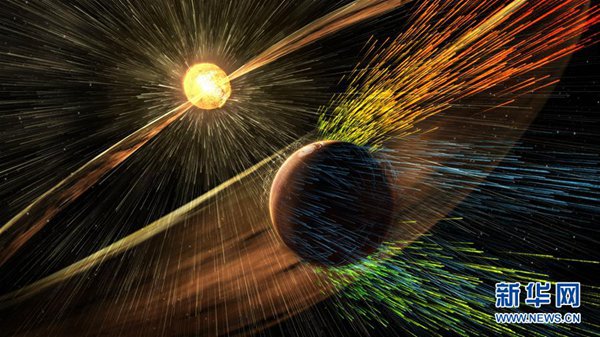Japan launches X-ray observatory to study deep space
Updated: 2016-02-17 18:29
(Xinhua)
|
|||||||||||
 |
|
An undated artist's rendering depicts a solar storm hitting Mars and stripping ions from the planet's upper atmosphere in this NASA handout released November 5, 2015. [Photo/Xinhua/APNASA] |
TOKYO -- Japan on Wednesday launched a new generation X-ray astronomy satellite aiming to reveal the structure of the universe and physics at extreme conditions in space.
The Japan Aerospace Exploration Agency (JAXA) and Mitsubishi Heavy Industries, Ltd. launched the X-ray Astronomy Satellite (ASTRO-H) aboard the H-2A Launch Vehicle at 5:45 p.m. (0845 GMT) on Wednesday from JAXA's Tanegashima Space Center in Japan's southwestern Kagoshima prefecture.
About 14 minutes after liftoff, ASTRO-H separated from the rocket. The satellite has been released from the upper stage of the H-2A rocket to begin a three-year mission.
The launch was scheduled for Feb.12, but was postponed due to unfavorable weather conditions.
The ASTRO-H satellite is the sixth in a series of Japanese X-ray missions since 1979 and is the successor to the SUZAKU satellite currently in space. Wednesday's launch is the first of the year 2016 for Japan.
ASTRO-H will "investigate the mechanisms of how galaxy clusters - the largest objects in space made of 'visible matter' - formed and influenced by dark energy and dark matter, to reveal the formation and evolution of supermassive black holes at the center of galaxies, and to unearth the physical laws governing extreme conditions in neutron stars and black holes," said JAXA.
"ASTRO-H will allow measurements of the curvature of space time. This is space time warped in close proximity to spinning black holes, something no-one has ever seen. The high precision observations of ASTRO-H will enable us to glimpse this for the first time," said the Japanese space agency.
"These observations are expected to lead to new ways of verifying Einstein's theory of general relativity," it said.
With overall length of about 14 meters and total weight of 2.7 tons, ASTRO-H is equipped with four telescopes and six detectors to study both hard and soft X-rays and gamma rays.
The four telescopes include a soft X-ray spectrometer (SXS), a soft X-ray imaging system (SXI), a hard X-ray imaging system (HXI), and a soft gamma-ray detector (SGD).
Many objects in deep space emit X-rays as well as visible light. Those X-rays, however, have wavelengths which are 1,000 to 100,000 times shorter than visible light. The best way to study X-rays from deep space is to use an orbiting telescope.
X-rays and gamma-rays from space are absorbed in the Earth's atmosphere, thus they cannot be observed on the Earth. Therefore observation in space is necessary.
Compared to the SUZAKU, ASTRO-H "will be able to perform spectroscopic observations on celestial bodies 10 times to 100 times darker than what the Suzaku was capable of doing," said JAXA.
ASTRO-H will orbit around the earth at an altitude of 575 km with an inclination angle of 31 degrees and complete one revolution every 96 minutes. It will maintain orbit near the equator and gather data for three years.
Led by Japan, the JAXA's project is an international collaboration with the participation of U.S. National Aeronautics and Space Administration (NASA), the European Space Agency (ESA), Canadian Space Agency (CSA), Netherlands Institute for Space Research, and universities in Japan, Europe and North America.
According to JAXA, proposals for observations will be accepted from all over the world after launch. As the sole large-scale public X-ray observatory, ASTRO-H will offer over 10 years of data to the public.
Related Stories
SpaceX launches satellite to deep space for 1st time 2015-02-12 09:33
US steps up military pressure on DPRK over satellite launch 2016-02-09 20:42
S. Korea confirms DPRK satellite's successful launch into orbit 2016-02-09 10:26
Beijing warns against increasing tensions over DPRK's satellite 2016-02-08 13:15
China regrets over DPRK's satellite launch 2016-02-08 09:49
UN Security Council kicks off emergency meeting on DPRK's satellite launch 2016-02-08 02:24
Today's Top News
Huawei bids to become 'Internet of Things' platform
Britain's Cameron defends EU deal
Sichuan opera proves a hit with UK audiences
WeChat to charge fees for digital wallet transfers
Stocks fall in China after holiday week
Putin, Obama discuss Syrian crisis over phone
Global stock swings not caused by China factors
Russian PM warns against 'new cold war' at MSC
Hot Topics
Lunar probe , China growth forecasts, Emission rules get tougher, China seen through 'colored lens', International board,
Editor's Picks

|

|

|

|

|

|






